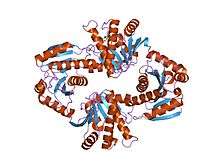Macro domain
| Macro | |||||||||
|---|---|---|---|---|---|---|---|---|---|
 Crystal structure of the macro-domain of human core histone variant macroh2a1.1 | |||||||||
| Identifiers | |||||||||
| Symbol | Macro | ||||||||
| Pfam | PF01661 | ||||||||
| Pfam clan | CL0223 | ||||||||
| InterPro | IPR002589 | ||||||||
| SCOP | 1vhu | ||||||||
| SUPERFAMILY | 1vhu | ||||||||
| CDD | cd02749 | ||||||||
| |||||||||
In molecular biology, the Macro domain or A1pp domain is a module of about 180 amino acids which can bind ADP-ribose, an NAD metabolite, or related ligands. Binding to ADP-ribose can be either covalent or non-covalent:[1] in certain cases it is believed to bind non-covalently,[2] while in other cases (such as Aprataxin) it appears to bind both non-covalently through a zinc finger motif, and covalently through a separate region of the protein.[3]
The domain was described originally in association with the ADP-ribose 1-phosphate (Appr-1-P)-processing activity (A1pp) of the yeast YBR022W protein and called A1pp.[4] However, the domain has been renamed Macro as it is the C-terminal domain of mammalian core histone macro-H2A.[5][6] Macro domain proteins can be found in eukaryotes, in (mostly pathogenic) bacteria, in archaea and in ssRNA viruses, such as coronaviruses, Rubella and Hepatitis E viruses. In vertebrates the domain occurs in e.g. histone macroH2A, predicted poly-ADP-ribose polymerases (PARPs) and B aggressive lymphoma (BAL) protein.
ADP-ribosylation of proteins is an important post-translational modification that occurs in a variety of biological processes, including DNA repair, regulation of transcription, chromatin biology, maintenance of genomic stability, telomere dynamics,[7] cell differentiation and proliferation,[8] necrosis and apoptosis,[9] and long-term memory formation.[10] The Macro domain recognises the ADP-ribose nucleotide and in some cases poly-ADP-ribose, and is thus a high-affinity ADP-ribose-binding module found in a number of otherwise unrelated proteins.[11] The Macro domain from human, macroH2A1.1, binds an NAD metabolite O-acetyl-ADP-ribose.[12]
The 3D structure of the Macro domain describes a mixed alpha/beta fold of a mixed beta sheet sandwiched between four helices with the ligand-binding pocket lies within the fold.[11] Several Macro domain-only domains are shorter than the structure of AF1521 and lack either the first strand or the C-terminal helix 5. Well conserved residues form a hydrophobic cleft and cluster around the AF1521-ADP-ribose binding site.[6][11][12][13]
References
- ↑ Hassa PO, Haenni SS, Elser M, Hottiger MO (September 2006). "Nuclear ADP-ribosylation reactions in mammalian cells: where are we today and where are we going?". Microbiol. Mol. Biol. Rev. 70 (3): 789–829. doi:10.1128/MMBR.00040-05. PMC 1594587
 . PMID 16959969.
. PMID 16959969. - ↑ Neuvonen M, Ahola T (January 2009). "Differential activities of cellular and viral macro domain proteins in binding of ADP-ribose metabolites". J. Mol. Biol. 385 (1): 212–25. doi:10.1016/j.jmb.2008.10.045. PMID 18983849.
- ↑ Ahel I, Ahel D, Matsusaka T, Clark AJ, Pines J, Boulton SJ, West SC (January 2008). "Poly(ADP-ribose)-binding zinc finger motifs in DNA repair/checkpoint proteins". Nature. 451 (7174): 81–5. doi:10.1038/nature06420. PMID 18172500.
- ↑ Martzen MR, McCraith SM, Spinelli SL, Torres FM, Fields S, Grayhack EJ, Phizicky EM (November 1999). "A biochemical genomics approach for identifying genes by the activity of their products". Science. 286 (5442): 1153–5. doi:10.1126/science.286.5442.1153. PMID 10550052.
- ↑ Aravind L (May 2001). "The WWE domain: a common interaction module in protein ubiquitination and ADP ribosylation". Trends Biochem. Sci. 26 (5): 273–5. doi:10.1016/s0968-0004(01)01787-x. PMID 11343911.
- 1 2 Allen MD, Buckle AM, Cordell SC, Löwe J, Bycroft M (July 2003). "The crystal structure of AF1521 a protein from Archaeoglobus fulgidus with homology to the non-histone domain of macroH2A". J. Mol. Biol. 330 (3): 503–11. doi:10.1016/S0022-2836(03)00473-X. PMID 12842467.
- ↑ Tennen RI, Chua KF (January 2011). "Chromatin regulation and genome maintenance by mammalian SIRT6". Trends in Biochemical Sciences. 36 (1): 39–46. doi:10.1016/j.tibs.2010.07.009. PMC 2991557
 . PMID 20729089.
. PMID 20729089. - ↑ Ji Y, Tulin AV (October 2010). "The roles of PARP1 in gene control and cell differentiation". Current Opinion in Genetics & Development. 20 (5): 512–8. doi:10.1016/j.gde.2010.06.001. PMC 2942995
 . PMID 20591646.
. PMID 20591646. - ↑ Han W, Li X, Fu X (2011). "The macro domain protein family: Structure, functions, and their potential therapeutic implications". Mutation Research. 727 (3): 86–103. doi:10.1016/j.mrrev.2011.03.001. PMID 21421074.
- ↑ Schreiber V, Dantzer F, Ame JC, de Murcia G (July 2006). "Poly(ADP-ribose): novel functions for an old molecule". Nature Reviews Molecular Cell Biology. 7 (7): 517–28. doi:10.1038/nrm1963. PMID 16829982.
- 1 2 3 Karras GI, Kustatscher G, Buhecha HR, Allen MD, Pugieux C, Sait F, Bycroft M, Ladurner AG (June 2005). "The macro domain is an ADP-ribose binding module". EMBO J. 24 (11): 1911–20. doi:10.1038/sj.emboj.7600664. PMC 1142602
 . PMID 15902274.
. PMID 15902274. - 1 2 Kustatscher G, Hothorn M, Pugieux C, Scheffzek K, Ladurner AG (July 2005). "Splicing regulates NAD metabolite binding to histone macroH2A". Nat. Struct. Mol. Biol. 12 (7): 624–5. doi:10.1038/nsmb956. PMID 15965484.
- ↑ Egloff MP, Malet H, Putics A, Heinonen M, Dutartre H, Frangeul A, Gruez A, Campanacci V, Cambillau C, Ziebuhr J, Ahola T, Canard B (September 2006). "Structural and functional basis for ADP-ribose and poly(ADP-ribose) binding by viral macro domains". J. Virol. 80 (17): 8493–502. doi:10.1128/JVI.00713-06. PMC 1563857
 . PMID 16912299.
. PMID 16912299.
This article incorporates text from the public domain Pfam and InterPro IPR002589